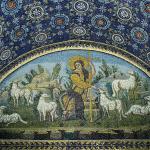Researching last week’s piece on tattooing revived somewhat my old interest in Polynesian culture. With no pig to stick or roast, I had to indulge my enthusiasm the virtual way — by watching a YouTube clip in which a mixed group of Maoris performs a war chant. The effect was suitably horrifying. The performers managed to sustain their fury till the end — a theatrical coup when you consider none of the chanters had much reason to be angry at anyone in the audience. In comparison, the Zulu war songs in the movie Zulu are more awesome, but it’s their harmonic complexity that inspires the awe and renders them, paradoxically, too beautiful to be altogether frightening. I daresay even I were cowering behind a sack of meal, the men of the hostile impi jabbing their aasegais at the place where my Adam’s apple would be if I raised my head, I wouldn’t be able to resist humming along.
But not even in the movies would Welsh soldiers interrupt a Maori chanting party by striking up a song of their own. To an English-speaker unfamiliar with Maori, the words sound an awful lot like ‘SHUTTHEFUCKUP,” and their delivery suggests that might not be so far from their actual meaning.
The memory of these bone-chilling imprecations returns to me as I search for the words to explain why I’ve never quite bought the late Maurice Sendak as a master of darkness. I read both In the Night Kitchen and Where the Wild Things Are when I was three, as receptive and impressionable an age as the author could want. And neither of the damn books scared me for a second. The Wild Things might have had terrible teeth and claws, but in every other respect they were cute. As potential threats, they were about as convincing as Elmer Fudd. Mickey’s nudity did weird me out slightly, but it was clear it didn’t weird him out a bit. In escaping the Oliver Hardy clones, he never loses his smartassed grin for an instant.
It wasn’t until turning six that I found myself really shaken by anything in literature. The book was Great Expectations, from which my mother read me a chapter every night before bedtime. When Magwitch ordered Pip to bring him a file and some rations “or I’ll have your lungs and liver out,” my hands flew to my ears. I felt the terror of helplessness before something strong and pitiless. In fact, for many years, I misremembered Magwitch’s threat as “I’ll eat your lungs and liver,” which may explain why I’ve spent a good part of my life making my own lungs and liver completely indigestible.*
This was the effect the Maoris had on me. The chant was so fierce, and so deadly serious, that I was able to smother any association I had of grown men in loincloths with Robert Bly. Instead, I heard the crack of a war club against my own skull. Switching to a modern context, I saw myself meeting a Maori in a bar, getting ever so slightly wide, and flying face-first through a window to become an unprotesting receptacle for dozens of Maori fists and boots. Any author (or author-illustrator) who can achieve this effect with the tools at his disposal can mark a reader for life, and not necessarily in a bad way. Horror is nothing if not thrilling; well-remembered horror represents a renewable resource.
In the New Yorker’s “Postscript,” Adam Gopnik writes: “What [Sendak’s] people seek is what we all seek: calm amid the storm of the world. They are studies in unostentatious courage—Max and Mickey don’t act out; they just carry on.” Resilience is an admirable quality, but it makes for dull reading unless some effort is made to dramatize the blips in it, those occasions where the hero or heroine is sure she’s going to lose, and goes slightly to pieces. It’s the moments when Bugs Bunny cries, “Yikes,” and when his ears sag in anticipation of doom, that make him a sympathetic — and relatively complex — character. Has anyone ever really given a tuppeny dam’ about the unflappable Road Runner?
Perrault and the Grimm brothers demonstrate just how possible this is when writing for very young readers. When we meet Cinderella, she’s been screwed royally by life, and experiences every one of her indignities to the fullest. If her fairy godmother offers her a better break than most of us can ever hope to get, it comes with all sorts of weird conditions, not unlike a credit card offer. In James and the Giant Peach, among other books, Roald Dahl employs the same pattern. Aunts Spiker and Sponge are so vile in their persons, and James Henry Trotter’s life with them so degraded, that hanging around with a bunch of giant, mutant insects seems like spring break in comparison. Beat that, anyone.
In an essay, Sendak recalled one of his first serious efforts at fiction, which he illustrated — and co-wrote with an older sister — at the age of nine or thereabouts. Titled “The Inseparables,” its title characters were a brother and sister who, like Tony and Cesca Carmonte in the original Scarface, were madly in love with one another. As they do for Tony and Cesca, things go badly for the Sendaks’ pair; the brother crashes his car and ends up in the hospital, bandaged from head to toe. Rather than accept this brake to their passion, the two lovers leap from a window, crying, “WE ARE INSEPARABLE,” and go splat.
In Sendak’s account, the story delighted his family, who provided him with his very first lecture-circuit stop. If Mom, Dad or a well-meaning uncle thought to take him aside and explain gently that brother-sister hookups are considered seriously uncool, even in royal families, he never mentions it. Although Sendak did go on to take a melancholy tone in some books for older kids, I’d say the gifts that first revealed themselves in “The Inseparables” are the ones that drove him ahead of the pack. These boil down to a whimsicality that domesticates the perverse and bizarre, making them fun, as the saying goes, for the whole family. That ain’t hay, but anyone who wants to give me nightmares is going to have to try a little harder.
*It turns out my memory is both worse and better than I gave it credit for. According to the Project Gutenberg edition, Magwitch threatens to extract Pip’s heart and liver. However, he adds that they’ll be “roasted, and ate.”















